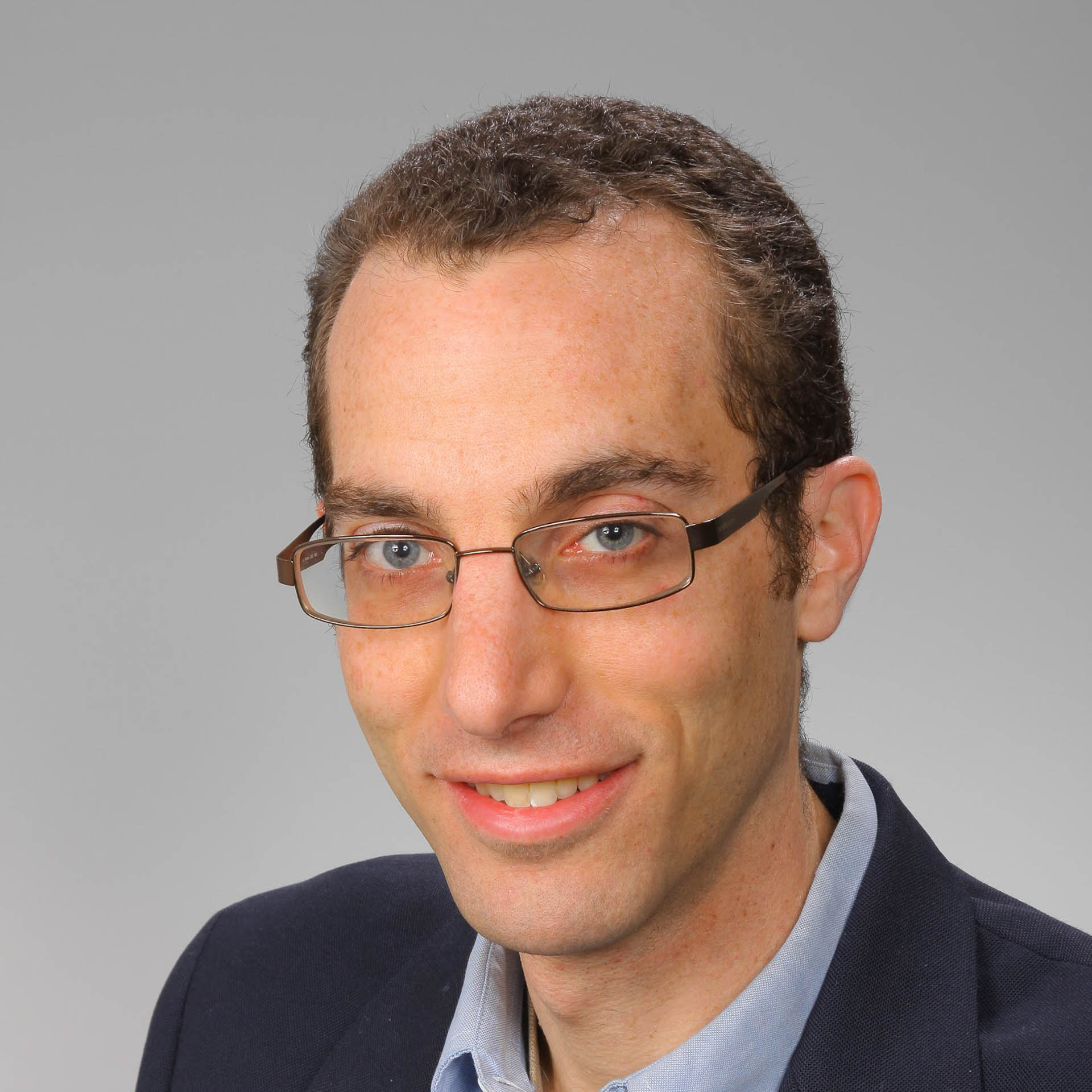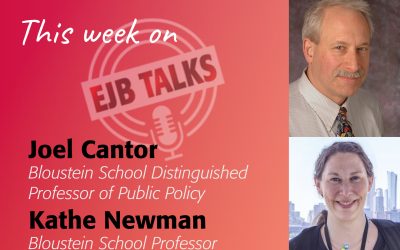In this episode, Stuart Shapiro talks with Professor Robert Kopp, one of the nation’s leading experts on climate change about what shaped his research agenda. They delve into the social cost of carbon and how quantifying the costs affect policy decisions impacting the climate. Dr. Kopp also discusses the evolution of the climate community and its realization that success in combating climate change required a closer understanding of the intersection with broader political concerns. They also reflect on the early Biden Administration climate policy initiatives. Finally, they cover Professor Kopp’s role on the Rutgers Carbon Neutral Task Force and how the university is focused on making climate action happen more quickly.
Stuart Shapiro
Welcome to EJB talks. I’m Stuart Shapiro, the Associate Dean of Faculty at the Bloustein School and the purpose of this podcast is to talk with my colleagues and our alumni about policy planning and health, the interaction between these issues and how they affect people in New Jersey, the United States and the world. Today, I’m very happy to have on Professor Robert Kopp who is a professor in the Department of Earth and Planetary Sciences here at Rutgers and is an affiliated member at the Bloustein School, and our go-to expert on climate change. Welcome to the podcast, Bob.
Robert Kopp
Great to be here.
Stuart Shapiro
So we’ll start with some introduction here. How did you originally come to the field of climate change?
Robert Kopp
So I started out as a pure science curiosity-driven person. I did my undergraduate work on life on Mars and then did a Ph.D. studying the history of life on earth and the way it’s affected climate over billions of years. And after spending several years doing that, I wanted to take what I had done, and combine it with an interest I also long had in policy. So I grew up in the DC area, both my parents work in government. And when I was a grad student at Caltech, I was active in the local Democrats. And so I had this long-standing interest. And so I wanted to take what I had done studying the history of the earth’s climate over billions of years and use it to work on modern climate change. So I spent two years at Princeton as a postdoc at what was then the Woodrow Wilson School, working with Michael Oppenheimer.
And then spent two years in DC as an AAAS Science and Technology Policy Fellow in the Office of Policy at the Department of Energy before ending up at Rutgers where I’ve been for about a decade. And so the course of my research agenda, and some of my other work, as a faculty member has really been shaped, particularly by those four years that I spent at Princeton, and at the Department of Energy. And so, that’s sort of how I ended up here.
Stuart Shapiro
I did not know about the life on Mars piece; that’s a subject for another podcast at some point. So yeah, you’re like me. My research agenda has been shaped by my time in Washington as well. Can you talk a little bit about that time and what you worked on while you were there?
Robert Kopp
Sure. So maybe I should go back and say what I was working on in Princeton too, and then I’ll talk about DC since I just said, that’s where my research agenda is shaped. So in Princeton, I started working on sea-level change. And because I was somebody who came from Earth history, I started looking particularly at how sea level has changed in the past, and what we can learn about that, that improves our understanding of sea-level change in the future. So that’s one thread that has sort of continued to run through my research group’s work here at Rutgers.
And then in DC, at the Department of Energy, I worked on a couple of areas. A big one, which we’ve continued carrying through at Rutgers involves something called the social cost of carbon. Which is basically a question of how, and we’ve talked about this a lot, how climate change gets incorporated into benefit-cost analysis, which is used by the US government for all sorts of things. The Department of Energy uses it for things like appliance efficiency standards, EPA uses it for its rules that affect carbon, and this was all relatively new in the Obama administration. So the Bush administration had started doing this in 2008, under court order. But the Obama administration was really sort of the first to look systematically at how to do this based on the scientific literature in a sort of standardized way across agencies. So that was a good chunk of my agenda at DOE.
And the other part focused on international Clean Energy and Energy Efficiency Cooperation. So I was involved in helping launch something called the Clean Energy Ministerial, which is a regular meeting of the Secretary of Energy or Minister of Energy of the major economies intended to move policy forward at a ministerial level, as well as specifically working on work around appliance efficiency cooperation. Which is certainly something I knew nothing about before I got to DOE. But turns out to be much more interesting than I think most people who haven’t spent any time thinking about appliance efficiency, would realize. It is a significant source of how we can get the energy system smaller so that it’s less of a lift to decarbonize it. So those were the two major things that I worked on, among other topics in DC.
And that work on the social cost of carbon has, since I’ve come to Rutgers, evolved into a large enterprise, that’s a collaboration with the University of Chicago and Berkeley and Rhodium Group called the Climate Impact Lab. Which is another one of the major areas my lab’s research focused on; How do we use big data and modern statistics and climate models to improve estimates of how people are harmed by climate change?
Stuart Shapiro
Oh, that’s interesting, I might want to actually come back to that because we’re certainly thinking a lot about big data with our new dean here at the Bloustein School as well. Let’s hit the social cost of carbon first, in part because it has recently been in the news, and also, I’ve just recently talked about it with my cost-benefit class. If you could explain to the layperson what it is, that would be great.
Robert Kopp
Sure, the simplest definition you can give is that the social cost of carbon is the damage to all society, that putting a ton of carbon dioxide into the atmosphere does. So there’s the thought experiment is you have a world it has climate change, you put another ton of carbon dioxide into the atmosphere, that will cause some additional damage for centuries to come. And then through the magic of discounting, you turn that stream of damages over the next several centuries into $1 value today. So it’s also a measure of what you should be willing to pay to avoid that dollar of damage.
Stuart Shapiro
Right, and of course, in the economist’s term, we think about it as the marginal impact of another ton of carbon going up. What are the practical implications of a higher value of it, of a lower value of it? How does its adoption or use affect our decisions on climate?
Robert Kopp
There are sort of two parallel histories of the social cost of carbon to think about. One is the social cost of carbon as an economic concept, which really goes back to work in the 60s and 70s, on the idea of the social cost of environmental pollutants, generally. And so there is some train of thought that would tell you “well, if you had an idea of a perfectly functioning market economy, the social cost of carbon should be the tax that you put on carbon dioxide emissions, to lead to an optimal output.” Now, of course, when you have significant uncertainties, and risk matters a lot, and inequality matters a lot, what optimal means is going to be very sensitive to that. So that’s one theoretical area.
And then there’s the practical area. This matters, particularly in the context of the US because the US and some of the other North American countries (less so Europe) have a strong tradition of benefit-cost analysis, for regulation. So if you write a new regulation, by executive orders, going back to the Reagan administration, it supposed to maximize the social benefit associated with that regulation, the net benefit. So taking into account the cost of regulation and the benefits. And so if you don’t use the social cost of carbon, then effectively, you’re saying that there’s zero-dollar value associated with reducing greenhouse gas emissions. And so if you have a regulation that reduces greenhouse gas emissions, it’s not going to be as stringent as if you took into account the fact that it’s beneficial to society to reduce greenhouse gas emissions.
Stuart Shapiro
And so we’re talking about power plant regulations, we’re talking about automobile standards, and we’re talking about the appliance efficiency standards you were discussing earlier.
Robert Kopp
Yeah, that’s an answer you could come up with other things. In theory, any regulation that has an impact on carbon dioxide emissions, or greenhouse gas emissions should take this into account. But those are the big ones. And some of these big ones are pretty small. Like the first interim Obama administration, the social cost of carbon estimates was associated with a vending machine appliance efficiency standard. The DOE, the Department of Energy hears all these little things, appliance efficiency standards that pick off bits. The EPA comes in with the big standards that address the entire electric sector.
But, the higher the social cost of carbon, the more regulation you can justify under a benefit-cost approach. So that why it’s significant, right? So the Trump administration had made a couple of choices regarding how much we devalue the future and whether we care about the world outside the US, which led them to use a very small social cost of carbon. And that was part of how they justified rolling back some of the regulations the Obama administration had proposed.
Stuart Shapiro
Right. So where’s this gonna go from now? What do you see the Biden administration doing, both in the social cost of carbon itself and also as the American jobs plan gets rolled out today, in climate change more broadly?
Robert Kopp
So social cost of carbon probably has a higher profile now than it’s ever had before. It was the topic of a day one executive order by this administration. And that executive order set two social costs of carbon deadlines. One was in a month effectively to come up with an interim value. And the interim value that the Biden administration is currently using is essentially very, very minor updates to what was the 2016 Obama role. So things like changing the year to which inflation is indexed, and small things like that.
The next deadline is going to be in about a year. So in January 2022. And that’s when there’s going to be, should be a full approach that takes into account some of the recommendations that the National Academies put forward in a report I was involved in, that came out in 2017. That includes things like thinking carefully about the discount rates. So, one of the things that’s pretty clear is that the discount rates used currently, not just actually for the SEC, but all regulatory analyses were based on a historical analysis that was conducted in 2003 of interest rates. And interest rates have been a lot lower in the following 18 years. So based on the argument used to set those discount rates, we’re discounting the future too much. So that’s one thing.
Another thing is damages. So this is really what our research group works on, is improving the databases for how we turn projected future climate change into projected harms to society. And then also for improving how the climate itself is modeled in these analyses. So all of these are things that the National Academies talked about. And all of these are things that the Biden administration and the interagency working group, that was set up by the executive order, is going to have to be looking at over the remainder of the next nine months to a year.
Stuart Shapiro
So it’s fair to say that you’re more optimistic in the ability to get things done. vis-à-vis the climate over the next four years?
Robert Kopp
Yes. I think we’ve certainly gone from heading in the wrong direction to heading in the right direction. I read this morning, some of the fact sheets on the American jobs plan, which is probably going to be President Biden’s big legislative push around climate. One thing that I think is significant is that in the decade, since the last major legislative push on climate, the whole issue has really been reframed as an industrial policy issue. So instead of thinking about it primarily as this externality and the right policies, essentially, to put a tax on it or work through cap and trade, limit emissions, and then let the market sort it out… that works great in economists models that have a perfectly functioning market economy with no political barriers. But in practice, it’s been hard to get there.
And the climate policies community has really realized that there needs to be much more focus on how climate intersects with other policy concerns. And one of the things is that it’s a big infrastructure issue. So we have to reshape the electric grid, we have to protect communities from the effects of climate change. We have to think about the distributional effects of climate impacts. So that was actually one of the big concerns with cap and trade and carbon taxes from the environmental justice community has to do with distributional effects and the way… If you’re focusing on carbon, you don’t necessarily focus on the immediate harms from say, a power plant in the community where it’s situated, which is almost very often going to be poor and black or poorer and more minority compared to the community at large. And so as we, in the industrial policy framing, those sorts of concerns are integral to how you think about addressing climate change.
Stuart Shapiro
From a political perspective, it’s always easier to spend your way to a solution than to tax and regulate your way to one, particularly in a polarized body politic as we have right now. Before we go I want to turn to another subject I know you said you wanted to talk about the role of universities. Obviously, the setting in which both you and I make our livings… What they can do about climate change. Can you talk about that for a couple of minutes?
Robert Kopp
Sure. I have a couple of relevant hats that I wear here, but one of them right now is that on behalf of our university President Jonathan Holloway, I’m co-chairing a task force on how the university gets to carbon-neutral and becomes more resilient. And one of the things that I think is a key part of that charge and sort of goes along with… yes actually Rutgers is a little late to be doing this compared to a lot of our peers, but we get to benefit from the decade of learning and climate policy as a consequence, is the recognition that how we think about the university as a catalyst of sustainable economic development writ large across the state really needs to be a core part of how we think about the climate action at a university level. We’re not just trying to put our own house in order, we have to think about the fact that we have a mission as a state university as a land grant university to help all of New Jersey.
And really, I think by working in New Jersey, which is a pretty interesting urbanized part of the megaregion… think about how you deal with sprawling mega regions and climate effects within them more broadly. So one of the things that I think is important to think about is how we do scholarship that actually benefits people. And the Bloustein School it’s sort of a core part of what you guys do. We also need to bring in the science disciplines and the engineering disciplines because this is not a problem that can be siloed within a single school, it really requires your net thinking about natural systems and human systems and engineered systems together to think about how we’re going to address climate change.
And so something I’m particularly excited about that we have now at Rutgers, that was established by the state last year’s in New Jersey Climate Change Resource Center, which can act as a focal point on campus for interfacing all the great work, all the scholarships that are use-inspired and relevant to solving climate change not just at Rutgers but at higher education statewide, serve as sort of the boundary workers who have a bridge between the universities and the communities. Make sure, helped facilitate the universities providing the information that people on the ground were trying to do climate planning for adaptation and mitigation need. And that’s I think a really exciting model, co-led by Marjorie Kaplan at the Rutgers Climate Institute and Jeanne Herb at the Bloustein School. I think things like that, how we bridge scholarship and on the ground need, to solve real-world problems, it’s something that we need to take from… to bring in all the disciplines of the university add something to bear on this and strengthen.
Stuart Shapiro
Yeah, that sort of practical outward-facing outlook is music to my ears and certainly one of the things we’ve focused on in this podcast. Let me let you wrap up with… you know obviously an issue we could talk about for hours, you could talk about for probably days or weeks on end… is there anything else you’d like to tell the audience sort of that’s hot and happening now? And hot, I didn’t mean that as an unintended pun there in the world of climate change.
Robert Kopp
I think it’s really, what we hit on before that which, I think settling into people’s realization that this cannot be siloed as an environmental issue or an issue that can be dealt with by a single agency. This is really fundamental to how we structure our economy and honestly it also closely relates to questions of democratic reform. We were in a situation where a substantial majority of the US population tells you that they support government action on climate, but we have a political system that gives disproportionate weight to the minority that doesn’t.
And so I had a column in the Star-Ledger a few months ago with the premise of which was ready, to solve the climate challenge we also need to think about how we’re going to solve our democratic challenges. That came out in October and obviously, in January we saw how severe some of those climate challenges are and we’re seeing with some of the voter suppression measures being passed. This is not a separate issue. Climate change really touches on everything. And I don’t think we’re going to be able to solve the climate challenge in the context of democracy while we are still struggling with ourselves about whether we’re actually going to be a democracy. And so the big point I would take away, that maybe it’s not obvious… that all of these things are related and how we function as a democracy is going to be core to how we are able to tackle the climate crisis nationally.
Stuart Shapiro
That’s a great message to end on. Thanks for coming on today, Bob.
Robert Kopp
My pleasure.
Stuart Shapiro
And thank you, as always, to Amy Cobb and Karyn Olsen for making the podcast work. We’ll be back next week with another talk with another expert from the Bloustein School till then stay safe.
[/toggle]




